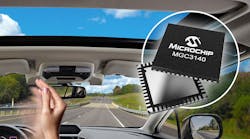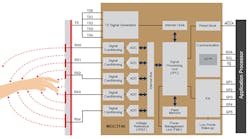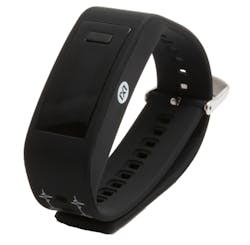Sensors are the backbone for the Internet of Things (IoT), used for everything from monitoring your pulse to the quality of air in your house. They track how well motors operate and even track motion.
Microchip’s MGC3140 (Fig. 1) is a three-dimensional (3D) gesture recognition controller that targets automotive human-machine interface (HMI) designs. This low-cost chip is Automotive Electronics Council AEC-Q100 qualified and has an operating temperature range of −40 to +125°C. It meets the electromagnetic-interference (EMI) and electromagnetic-compatibility (EMC) requirements for automotive systems.
1. Microchip’s MGC3140 is a three-dimensional (3D) gesture-recognition controller that targets automotive HMI designs.
The MGC3140 uses the company’s patented GestIC technology that tracks natural hand and finger movements in free space. GestIC Colibri Suite support is handled by the chip, and it recognizes a wide range of gestures.
The 3D sensor chip utilizes an electric field (E-field) for advanced proximity sensing (Fig. 2). The system isn’t affected by changes in sound or lighting that influence other 3D motion-sensing solutions. Its carrier frequencies, which range from 42 to 100 kHz, don’t compete with other wireless technologies.
2. The MGC3140 leverages GestIC technology, which tracks natural hand and finger movements in free-space using an electric field for advanced proximity sensing.
In the Air
Next we look at Integrated Device Technology’s (IDT) ZMOD4410 sensor (Fig. 3), which is used to track indoor air quality. This chip sensor can be used in the home, commercial locations, and in automotive settings. Given that we spend almost 90% of our time in these environments, it’s useful to know if volatile organic compounds (VOCs) are floating around. Sometimes we can smell these, sometimes we cannot. VOCs can have health effects ranging from irritation, headache, fatigue, and even cause serious illnesses like cancer.
3. The ZMOD4410 sensor from IDT is used to track indoor air quality.
The ZMOD4410 MEMS sensor heats a sensing material that changes resistance when a target gas is detected. It provides fast detection response in addition to being very sensitive and stable. The sensor can operate via diffusion or under active air flow. It can also provide estimated CO2 via correlation with sensor data.
The sensor fits other applications such as mass flow controllers. It can track solvent evaporation and it can be used in a variety of commercial and production applications.
On the Wrist
Maxim Integrated's highlights its MAX86140 optical pulse-oximeter/heart-rate sensor and MAX20303 wearable power-management solutions with the Max-Health-Band (Fig. 4). It turns for a week on a single charge and can reduce application design time by up to nine months.
4. Maxim’s Max-Health-Band has a removable module that tracks steps and heart rate.
It’s similar to other health wristbands in that it streams data via Bluetooth to an Android application. Unlike consumer products, Maxim’s solution provides access to raw data along with heart rate, heart-rate variability, step count, and activity classifications for developers to utilize and customize their analysis.
A removable rectangular module includes the display. This can plug into a USB connection for charging and download. Developers can then take this design and optimize it for an end product.
On the Road
STMicroelectronics’ ASM330LHH (Fig. 5) is a six-axis sensor with a 3D accelerometer and 3D gyroscope that targets automotive applications. It’s an ultra-low-noise ThELMA (thick epitaxial layer for micro-gyroscopes and accelerometers) MEMS device with high linearity and built-in temperature compensation. It eliminates the need for external compensation algorithms over its operating range that includes temperatures up to 105°C. The wide temperature range enables more design freedom in placement near hot areas, such as in smart antennas on the vehicle roof or near the engine compartment.
5. The ASM330LHH six-axis sensor developed by STMicroelectronics, featuring a 3D accelerometer and 3D gyroscope, targets automotive applications.
The sensor is qualified according to AEC-Q100 automotive-grade standards. It comes in a low-profile 3- by 2.5- by 0.83-mm, 14-lead, land-grid-array (LGA) package.







